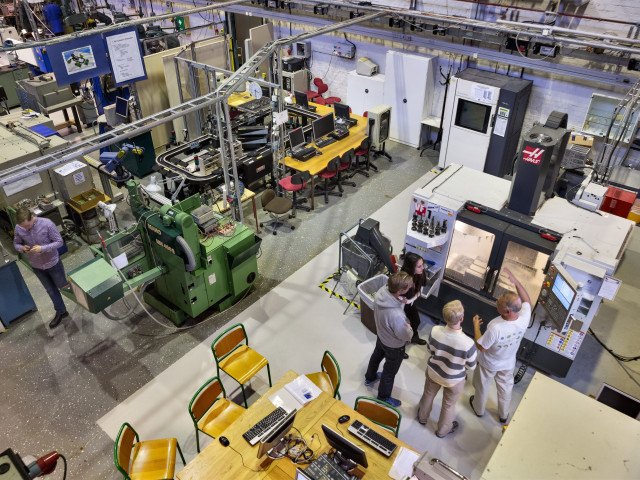- Climate and ventilation
- Lighting and visual ergonomics
- Electromagnetic radiation
- Chemical and microbiological hazards
- Physiology and injury mechanisms
- Theories on acute and long term health effects
- Measurement methods, measurement strategies and risk assessment
- Work environment regulations in the field
- Intervention strategies
HN2017 Evaluation and Measures of the Physical and Chemical Work Environment 15.0 credits

Information per course offering
Course offerings are missing for current or upcoming semesters.
Course syllabus as PDF
Please note: all information from the Course syllabus is available on this page in an accessible format.
Course syllabus HN2017 (Autumn 2019–)Content and learning outcomes
Course contents
Intended learning outcomes
The overall aim is to provide knowledge about climate and ventilation; lighting and visual ergonomics; electromagnetic radiation; and chemical and microbiological hazards at the workplace, their impact on safety, health, well-being, and performance. The objective is also to provide knowledge about how to manage these factors and reduce risks, through technical and organisational design of work, workplaces and the work environment.
The course is divided into two blocks, Block A: Chemical and microbiological hazards and Block B: climate and ventilation; lighting and visual ergonomics; electromagnetic radiation.
By the end of the course, the students should be able to:
Block A and B
1. Describe, exemplify and explain how all the above-mentioned factors affect safety, health, well-being and performance.
2. Perform measurements and risk assessments relating to all the above-mentioned factors in order to assess exposure as well as understand the causes of exposure and provide a basis for control measures that eliminate or reduce the causes. Measurements include knowledge about measuring methods as well as measurement strategies.
3. Describe what different measuring strategies can be used for and critically analyse measuring strategies. Be able to interpret results from measurements and understand what conclusions can be made and analyse the limitations of measurements.
4. Propose work environment improvements according to the hierarchy of control concerning the above-mentioned factors.
5. Critically discuss risk assessments and work environment improvements in relation to relevant work environment regulations.
6. Describe the EU regulations and Swedish legislation and provisions for all the above-mentioned factors.
Block A: Chemical and microbiological hazards
7. Find and interpret information about health hazards with chemical products and substances and use this information in risk assessment of handling of and exposure to chemicals.
8. Describe common microbiological risks, in what environments they occur how such risks can be assessed and how they can be controlled.
9. Describe the demands on management of chemical risks and be able to support organisations and adapt the management methods to organisations needs and prerequisites.
10. Discuss pros and cons with different control measures and strategies and identify facilitators and barriers for implementation
Block B: climate and ventilation; lighting and visual ergonomics; electromagnetic radiation
11. Describe and reflect on theories about sociotechnical (human, technology and organisation) perspectives linked to climate and ventilation; lighting and visual ergonomics; electromagnetic radiation.
Literature and preparations
Specific prerequisites
Academic first degree, 180 higher education credits in engineering or natural sciences or equivalent education. 15 credits in mathematics or statistics.
Literature
- Technology and work on human terms, Prevent, ISBN 9789173650588.
- W507 Health effects of hazardous substances. Student manual.
- W501 Measurement of hazardous substances. Student manual.
- W505 Control of hazardous substances. Student manual.
- e-tool Dangerous substances (link will be provided when this English translation of KemiGuiden is published or in Swedish: KemiGuiden, www.kemiguiden.se)
- Chemical Hazards in the Working Environment (AFS 2011:19Eng) (på svenska: AFS 2014:43 Kemiska arbetsmiljörisker)
- HSE website, information on microbiological risks, http://www.hse.gov.uk/biosafety/information.htm (or in Swedish: Alvarez de Davila E. Mikroorganismer i arbetsmiljön. ISBN 97-8917-365-0236, Prevent, this book can be obtained from the course leader)
- EU-directives on indicative limit values (or in Swedish: AFS 2015:7 Hygieniska gränsvärden)
- Vetenskapliga artiklar och litteratur som presenteras vid kursstart och som redovisas på kurswebben.
- Kompletterande litteratur (frivillig men rekommenderad för svensktalande studenter Process- och industriventilation. ISBN 91-7522-894-7, Prevent 2005
Examination and completion
Grading scale
Examination
- ÖVN1 - Exercises, 2.0 credits, grading scale: P, F
- TEN1 - Examination, 6.5 credits, grading scale: A, B, C, D, E, FX, F
- RED1 - Examination, 5.0 credits, grading scale: P, F
- LAB1 - Laboratory Work, 1.5 credits, grading scale: P, F
Based on recommendation from KTH’s coordinator for disabilities, the examiner will decide how to adapt an examination for students with documented disability.
The examiner may apply another examination format when re-examining individual students.
If the course is discontinued, students may request to be examined during the following two academic years.
Other requirements for final grade
Passed written and oral presentation of assignments and active participation in exercises and laboratory work. The final grade (A–F) for the entire course requires completed tasks as described above and grade A–F on both the written examinations. The final grade is calculated as the average of the two written examinations (TEN1 and TEN2).
Examiner
Ethical approach
- All members of a group are responsible for the group's work.
- In any assessment, every student shall honestly disclose any help received and sources used.
- In an oral assessment, every student shall be able to present and answer questions about the entire assignment and solution.